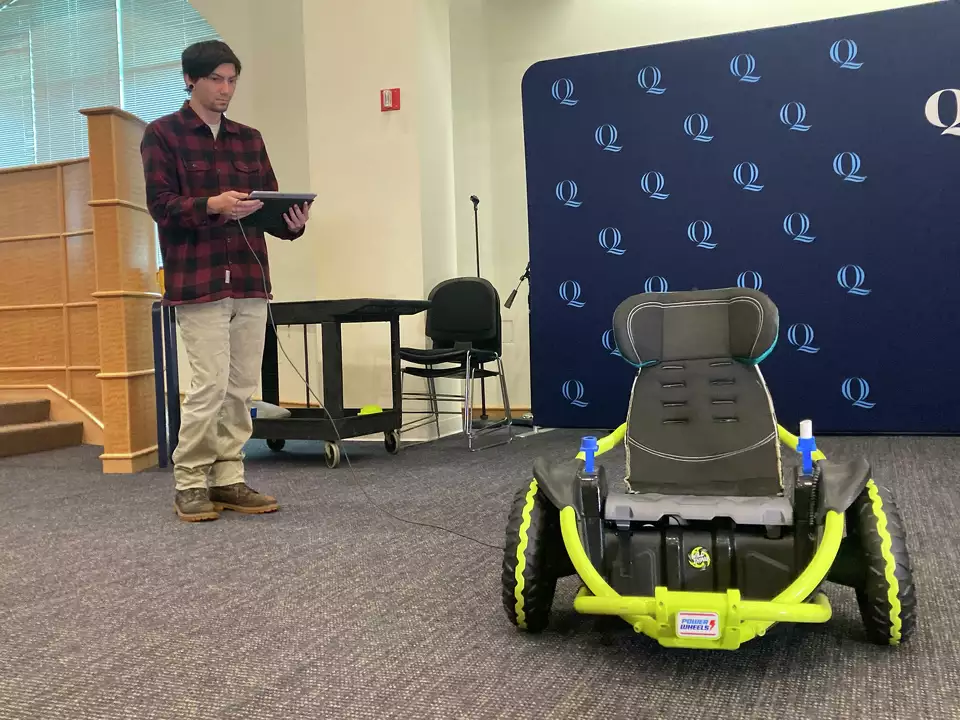Introduction to the Innovative Technology
The intersection of creativity, engineering, and social responsibility has led to remarkable advancements in assistive technology, significantly improving the quality of life for individuals with disabilities. A pioneering group at Quinnipiac University has developed a groundbreaking tool that enables users to control various devices through facial movements. This innovative device meets a crucial need for greater accessibility in technology, providing an empowering solution for those who may find traditional methods of interaction challenging or impossible.
Motivated by a desire to enhance the daily lives of individuals with physical limitations, the Quinnipiac team delved into the possibilities of harnessing facial recognition technology. Their inspiration stemmed from observing the barriers faced by users with disabilities when interacting with current technological devices. Recognizing the potential for a face-controlled device to bridge the gap between capability and accessibility, the team embarked on a mission to create a tool that is both functional and user-friendly.
This invention is not merely a technological breakthrough; it symbolizes a significant step towards inclusive innovation. By prioritizing accessibility, the Quinnipiac group recognizes the importance of tailoring technology to meet the diverse needs of the community. This groundbreaking tool has the potential to revolutionize various aspects of daily life—encompassing communication, entertainment, and home automation—by allowing users to interact with their environments seamlessly.
As we delve deeper into the impact of this innovative face-controlled device, it becomes apparent that such advancements are imperative in fostering equality and independence. The significance of this technology transcends mere functionality; it speaks volumes about the evolving responsibility of engineers and creators to prioritize accessibility in their designs. Ultimately, this tool is poised to make waves in the realm of assistive devices, paving the way for a more inclusive and accessible future.
How the Tool Works
The face-controlled device tool developed by the Quinnipiac group utilizes advanced technology comprising both hardware and software components that facilitate efficient face tracking and device interaction. At the core of this system is a high-resolution camera, which captures the user’s facial movements and translates them into precise commands for various devices. This camera is integrated with sophisticated algorithms designed to recognize specific facial expressions and gestures, enabling seamless interaction with technology.
The underlying software is a complex amalgam of computer vision algorithms and machine learning models that process the visual data in real time. These algorithms are trained to identify key facial landmarks, allowing for accurate tracking of movements such as nodding or blinking. Users can operate several devices simply by shifting their facial position or expressing different emotions, thereby granting autonomy to individuals with mobility limitations.
User experience is paramount in the design of this tool. The interface is intentionally minimalist, featuring large, accessible buttons and clear visual instructions that guide users through the setup and operation processes. Designed with intuitive navigation in mind, it minimizes physical and cognitive strain, making it suitable for users of various ages and capabilities. Feedback mechanisms, such as visual prompts or auditory acknowledgments, enhance the interaction experience, ensuring users are continuously aware of their inputs and the corresponding system responses.
Examples of devices that can be controlled with this innovative tool include smart home appliances, computers, and even electronic wheelchairs. Each of these devices can be integrated seamlessly, allowing users not only to control their immediate environment but also to maintain greater independence. By leveraging face-controlled technology, the Quinnipiac group is setting new benchmarks in accessibility, providing users with much-needed empowerment and confidence in navigating their surroundings.
Real-Life Applications and Benefits
The innovative face-controlled device tool developed by the Quinnipiac Group represents a significant leap forward in assistive technology, particularly for individuals with disabilities. This groundbreaking tool offers a range of practical applications across various contexts, highlighting its potential to transform the lives of users.
One notable application is its utility in enabling users to interact with smart home devices. For individuals with limited mobility or dexterity, controlling lights, thermostats, or entertainment systems can be challenging. The face-controlled device tool allows users to manage these systems using simple facial gestures, enhancing their autonomy and comfort in their living environments. Testimonials from users indicate that this technology has markedly improved their independence, allowing them to engage with their homes more effortlessly than ever before.
Moreover, the tool has proven invaluable in educational settings. Students with physical disabilities have reported significant advantages in participating in classroom activities and engaging with educational content. By utilizing facial movements to navigate digital interfaces, these students can access learning materials and join discussions with their peers seamlessly. This fosters an inclusive environment where all students can thrive, underscoring the potential of assistive technologies to promote educational equity.
The face-controlled device tool also serves critical functions in communication. For individuals with speech impairments, it provides an alternate method of expressing needs and thoughts, greatly enhancing their ability to connect with others. Users have shared their experiences of feeling more included in social interactions, expressing that this technology helps bridge the communication gap that often isolates those with disabilities.
In conclusion, the face-controlled device tool from the Quinnipiac Group exemplifies a transformative advance in assistive technology. The positive impact on users’ independence, interaction, and overall quality of life underscores the importance of continued innovation in this field. As this technology becomes more widely adopted, its potential to revolutionize accessibility remains profound and far-reaching.
Future Prospects and Development
The Quinnipiac group has embarked on a pioneering journey with their face-controlled device tool, aiming to enhance accessibility for individuals with physical disabilities. As they advance in their research and development efforts, the focus is on refining the technology to broaden its functionality and improve user experience. In achieving this, the team is actively exploring a variety of enhancements, including improved accuracy and responsiveness of the device to facial movements, which will make it more intuitive and user-friendly.
Furthermore, the potential for collaborations with other organizations cannot be understated. By partnering with tech firms specializing in artificial intelligence and machine learning, the Quinnipiac group can leverage advanced algorithms that enhance the tool’s performance. Collaborative efforts with healthcare organizations could also facilitate valuable feedback from users, ensuring that the device meets the real-world needs of its target audience. Such partnerships are essential for sanguine expansion and development of the technology.
Looking ahead, there are promising prospects for commercially launching the face-controlled device tool. With the increasing demand for assistive technologies, driven by a growing awareness of accessibility issues, the device stands to occupy a significant niche in the market. Successful commercialization would not only provide financial backing for further research but also make this innovative tool widely available to those who need it most.
The impact of this technology on the accessibility landscape could be profound; it holds the potential to transform how individuals with disabilities interact with their environment, leading to greater independence and improved quality of life. The need for ongoing innovation in assistive technologies has never been greater, as societal shifts demand advanced solutions for accessibility challenges. Therefore, the relentless pursuit of refinement and enhancement is crucial to meet the evolving needs of users in a dynamic technological landscape.
















